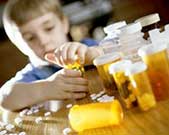|
|
 |
|
The views expressed on this page are soley
those of the author and do not
necessarily represent the views of County
News Online
|
 |
Know! To
Educate and Rx-Proof Students
1/31/2018
Aside from prescription drug abuse being illegal, it is highly
dangerous. Yet one in four high school students will use a prescription
medication for non-medical reasons at least once before graduating.
Youth say prescription drugs are easier to access than a six-pack of
beer. So where are students getting these prescription meds? 64 percent
of youth report obtaining prescription drugs from their home medicine
cabinets or from other family members or friends.
An essential part of preventing teen Rx drug abuse is for students to
have a prescription-proofed home. Teachers can remind parents to do so
through this simple, three-step approach:
SECURE. All medications, including over-the-counter, should be safely
stored in a lock box.
MONITOR. Parents and other caregivers should know what is inside that
medicine lock box and regularly monitor its contents.
DISPOSE. Properly disposing of unused or expired medication is also
vital in preventing prescription drug misuse and abuse. Click here for
proper disposal guidelines from the FDA. And when available, take
advantage of local drug take-back programs to safely dispose of
medications. Click here for available take-back locations.
It is important for all community members to follow the safety
guidelines to prescription-proof our homes, but it is especially vital
for those who come in contact with children.
When it comes to prescription-proofing students however, it is
definitely more challenging. In fact, aside from a child who is
monitored 24/7, no teacher can ever say with certainty that a
particular student is not at-risk for misusing or abusing prescription
drugs, regardless of academic performance or extra-curricular
activities. Even star students and celebrated athletes sometimes make
poor choices.
Teachers can, however, increase their students’ chances for making good
choices surrounding prescription drugs with these tips:
Know! Why Youth Use Rx Drugs: Most youth say they use Rx drugs to get
high, treat pain, sleep, stay awake, fit in or do better in school.
Interestingly, boys are more likely to abuse Rx drugs to get high,
while girls tend to use Rx drugs to stay alert or lose weight.
Know! The Common Rx Drugs of Abuse: The most commonly abused drugs by
youth include prescription pain medication, anti-anxiety or sleep
medication, medication to treat ADHD and over-the-counter cough or cold
medicine.
Dispel Rx Drug Myths: The majority of youth believe Rx drugs are safer
than illicit street drugs, but that is FALSE. Make sure your students
are aware that Rx drugs can be just as dangerous, addictive and
damaging to one’s developing body and mind, as illicit street drugs.
Communicate Regularly: Talk openly with students about the hazards of
Rx drug abuse. Ask them what they know and want to know on the subject,
and if you don’t have the answer, research it and get back with them.
When your students speak, listen carefully.
Rx medication abuse remains a significant part of the teen drug
problem. Teachers are in a position to positively impact the lives of
students by guiding them toward making healthy decisions, such as
choosing not to misuse or abuse drugs of any kind. While parents have
the ability to eliminate access and availability in the home, teachers
have the ability to lead and keep this critical conversation going,
among peers, in the classroom.
If a student or anyone else is in need of Rx drug intervention or
support, call the Treatment Referral Helpline at 1-800-662-HELP or
visit www.samhsa.gov/treatment.
Learn how to get the conversation started at StartTalking.Ohio.Gov
|
|
|
|

